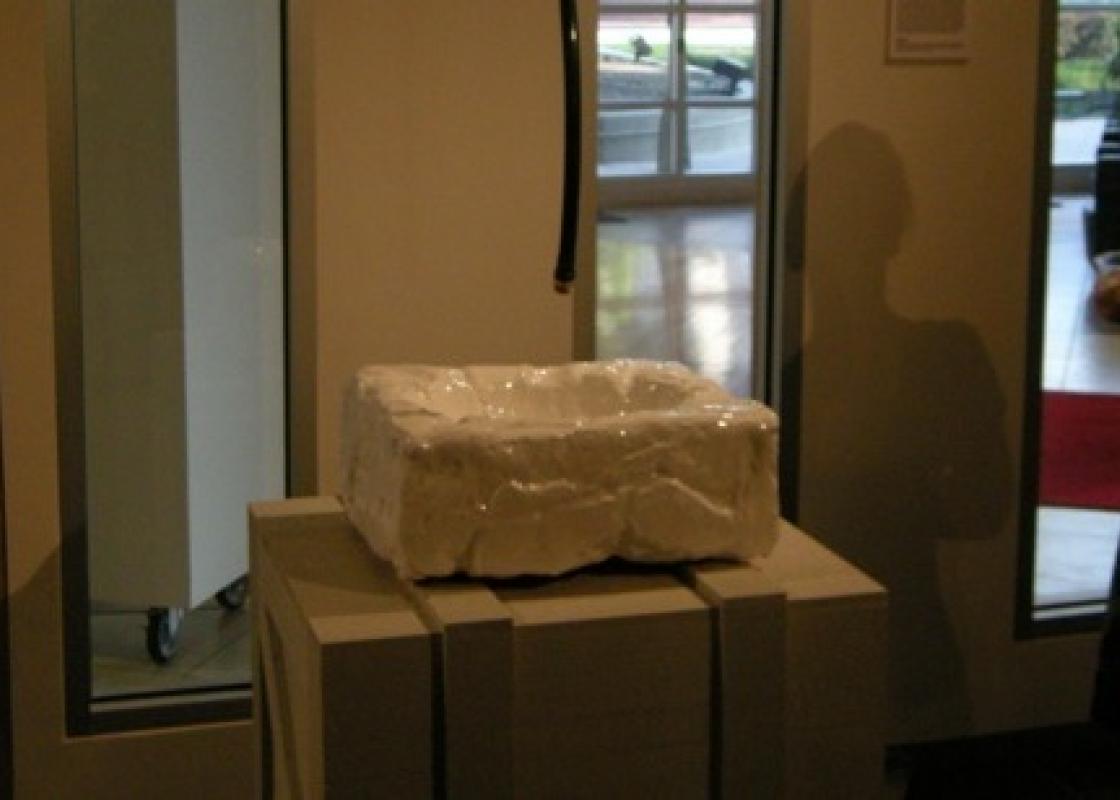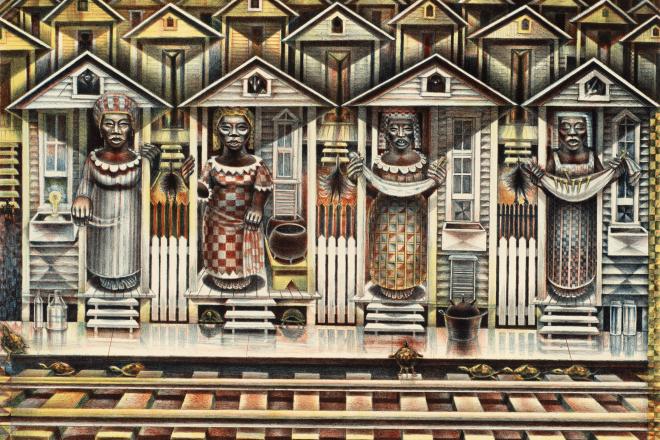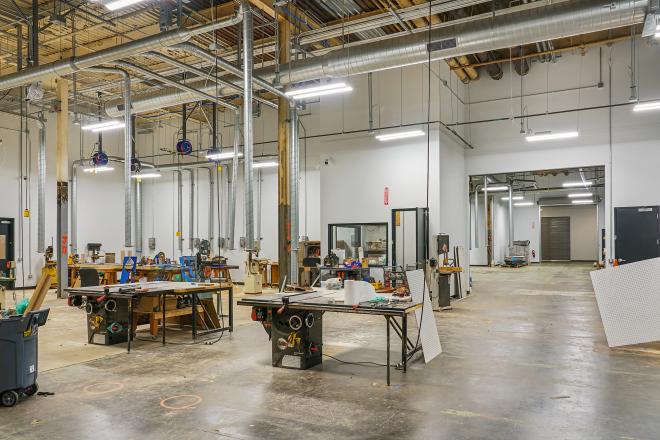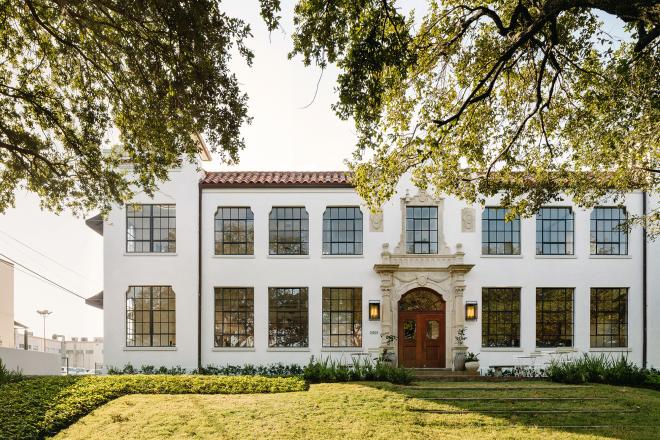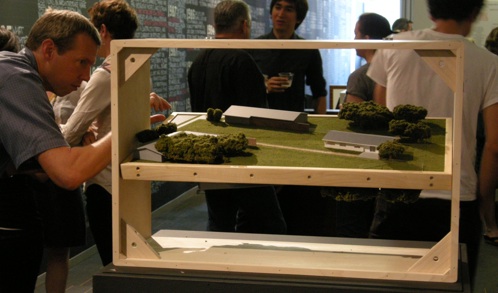
Photos by Steven Thomson
It is befitting that the Architecture Center Houston is positioned in the shadow of City Hall, and a glut of the city’s engines of cultural production --- the Hobby and Wortham centers, Jones Hall --- and the corporate headquarters that fuel them, as the site is currently host to an exhibition that examines the interactivity between these elements. Policy is a collaborative exhibition by Mary Ellen Carroll with Daniel Anguili, Alberto Govela, Samuel Jacobson, Matt Stilt, Kevin Topek, Carlisle Vandervoort, and Seanna Walsh. Although the show occupies a modestly-sized portal and narrow corridor beneath the Houston American Institute of Architects (AIA) headquarters, it proposes an intrepid level of discourse on the relationships surrounding policy, art, architecture, and urbanism.
The exhibition draws from the musings of conceptual artist Mary Ellen Carroll, also known for her ongoing transformation and ultimate rotation of a Sharpstown ranch house by 180 degrees. The gesture is meant to reposition the property as a piece of “performative” architecture. The inspiration for Prototype 180 may be traced to a cathartic moment in 1999, when Carroll was mired in Los Angeles traffic on Highway 405, and began to deconstruct the notion of public art, which she recounts in the exhibition’s text:
I then started to think about the 80s and 90s and how architecture successfully usurped the role of art in the public, and not as 'public art' per se, but where the intention and scale were no longer possible or being considered. The architecture that assumed this role was using form and surface in a manner that was considered 'sculptural.'
It was with this revelation that Carroll took to the streets of Sharpstown to create her provocative “innovation territory.” “The thing that’s really interesting about Sharpstown as an area is that it’s a first ring suburb,” she explains, “and almost every metropolitan area has that first ring suburb.” Houston has witnessed the tumultuous journey of Sharpstown, from its idealist vision in the 1950s, to the indictment of Frank Sharp and perceived decades-long decay, and the current move to revive the area with such projects as rebranding Sharpstown Mall as PlazAmericas. For Carroll, Sharpstown is an innovation territory in Houston, and Houston is an innovation territory in the United States.
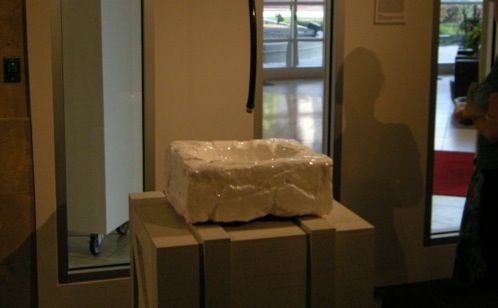
In Policy, Carroll presents developing components of Prototype 180, including a new ceramic cladding, “Pigro,” developed with the Kohler Company to replace the home’s original wood exterior. Pigro translates to lazy in Italian and was the basis for the material’s manufacturing process, which utilizes a foam packaging material that evaporates when it is fired. Once dipped in a porcelain slip, the form becomes vitreous china when fired and exists as a hollow casted body. Hence, the need for a mold is eliminated. (Note, this is a conceptual process not one carried out.)
The most notable innovation presented in the exhibition is the “Hygro Curtain Wall,” a “green wall” prototype for a proprietary system created by Mary Ellen Carroll’s MEC design studios, Kevin Topek of Permaculture Design, LLC, and Carlisle Vandervoort. The installation unwraps the metaphor of modern architecture’s “curtain wall” into a “biopolitical actualization.” With its pockets of soil and matrix of lattice irrigation wires, Hygro presents solutions to food production in areas with otherwise insufficient water and poor soil. The design would feature articulated water emitters powered by solar pumps, polycarbonate “soil” laced with sensors for triggering the irrigation system, and a track system that, with power derived from solar panels, automatically adjusts to weather and light conditions for optimal growing conditions.
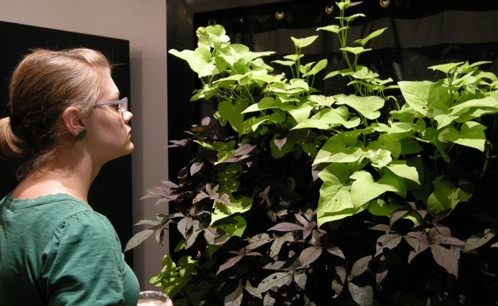
“Pigro” and “Hygro” are the most tangible aspects of Policy, but the bulk of the exhibition is a close reading of the past 60 years. This is an exhibition seeking to come to terms with the inherent links --- and disconcerting ruptures --- between policy and design. The exhibition planners have carefully selected choice moments in the past half-century, ranging from Sharpstown in the 1950s to Spain in the ‘90s. The information is broken into a series of digestible quotations, hard facts, and sound bites. The format is timely in an age of streaming headlines and rapid-fire Twitter updates, yet the chosen phrases are poignant, and their scrolling across the length of the exhibition along a painted-on chalkboard point to Carroll’s accomplices' lives as Rice University architecture students. Responsible for the actual writing on the wall is Matt Stilt, a graffiti artist who has merged the urban typeface with the iconic handwriting of an architect.
In terms of content, Houston and Sharpstown serve as the starting points, such as the Houston Chamber of Commerce’s 1953 declaration of Houston as the nation’s most air-conditioned city, and the imposing of Sharpstown’s deed restrictions two years later.
The timelines eschews hierarchy, juxtaposing the formation of a local neighborhood with the 1951 declaration by the American Committee for Cultural Freedom that “democracy, not communism creates societies where art thrives.” The text highlights that stalwarts of post-WWII art and theory like Clement Greenberg, Jackson Pollock, and Alexander Calder collaborated with the Committee in opposition to fascism.
The inextricable links between business and culture are posted on the wall,
1969: John and Dominique (nee Schlumberger) de Menil acquire the following works by Tony Smith: ‘The Elevens are Up’ (1963) and ‘New Piece’ (1966),
beside the global forces that leveraged (and tainted) them:
1973: October 17—OPEC oil ministers agree to use oil as a weapon to influence the West’s support of Israel in the Yom Kippur War. An embargo is extended against non-complying states, including the U.S.A.
As Policy so plainly delineates, corporate corruption and cultural patronage are never far apart. One of the most timely entries concludes with a quotation from Los Angeles County Museum of Art executive director, Michael Gowan:
2007: LACMA accepts a $25 million “donation” from BP that shall aid in the renovation of the museum. The entryway on LACMA’s newly expanded campus is hereby renamed 'The BP Grand Entrance.' ‘LACMA is proud to partner with BP. What is convincing to LACMA is their commitment to sustainable energy.’
Yet for all of the expertly arranged neologisms, Policy proffers no agenda. Instead, the exhibition stands as an exhaustive look at the autonomous instances of policy that have shaped the city. The bits of text, which draw connections that are at once affirming and ominous, speak for themselves. Even a video installation, which features interviews of Sharpstown’s denizens, from community leaders to original residents, grants a full-spectrum viewpoint.
In typical Carroll fashion, the exhibition turns itself inside out, and takes the discourse beyond AIA’s corridors and onto the building’s balcony. There, passersby on I-45, Memorial Drive, and even Landry’s Downtown Aquarium, can glimpse from their seats a neon installation reading, “IN OTHERS COUNT.” The three words were originally penned by Alexis de Tocqueville, whose manner of detached social science investigation can be found even in the work of Carroll, despite a separation of nearly two centuries.
“One of the things I sought to explore was the reuse of material, and how the media can play a role in all of this,” says Carroll. While the exhibition was already in planning stages, she noticed an abandoned neon sign for the Houston Chronicle outside the newspaper’s downtown office. After a phone call to the daily’s headquarters, the sign was donated and neon company NEC offered to retrofit it to spell de Tocqueville’s iconic phrase. When refurbishing the Chronicle’s sign proved burdensome, NEC fashioned a new sign to function as the exhibition’s exterior voice. “It’s not a sign; it’s a work of art,” Carroll clarifies. Like Duchamp’s urinals, policy in itself is the artist’s readymade medium.
The show’s interactivity does not end at the AIA balcony, however. The exhibition organizers have organized a charrette, featuring entries that reconsider the design and purpose of the mall formerly known as Sharpstown. A review of the entries, and the closing of Policy, will take place July 9. It’s just one more statement by Carroll and her colleagues on the play between policy and architecture. “Architecture is inherently a political act,” emphasizes Carroll, “And we are living in the political epoch.”


